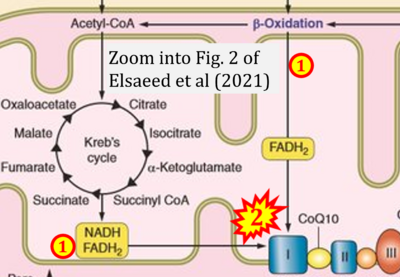Difference between revisions of "Elsaeed 2021 Medicine Updates"
(Created page with "{{Publication |title=Elsaeed EM, Hamad A, Erfan OS, Elshahat M, Ebrahim F (2021) Role played by hippocampal apoptosis, autophagy and necroptosis in pathogenesis of diabetic co...") |
|||
| Line 10: | Line 10: | ||
|editor=Gnaiger E | |editor=Gnaiger E | ||
}} | }} | ||
[[File:Elsaeed 2021 Medicine Updates CORRECTION.png|right|400px]] | [[File:Elsaeed 2021 Medicine Updates CORRECTION.png|right|400px]] | ||
{{Template:Correction FADH2 and S-pathway}} | {{Template:Correction FADH2 and S-pathway}} | ||
Latest revision as of 13:49, 19 December 2023
| Elsaeed EM, Hamad A, Erfan OS, Elshahat M, Ebrahim F (2021) Role played by hippocampal apoptosis, autophagy and necroptosis in pathogenesis of diabetic cognitive dysfunction: a review of literature. Medicine Updates 6:41-63. https://doi.org/10.21608/muj.2021.75897.1052 |
Elsaeed EM, Hamad A, Erfan OS, Elshahat M, Ebrahim F (2021) Medicine Updates
Abstract: Cognitive dysfunction is an important comorbidity that affects diabetic patients of different types and at different ages. A wide range of cognitive deficits can occur depending on many factors such as the type of diabetes, age of its onset and whether properly controlled or not. Mechanisms of diabetic cognitive affection in children and elderly patients are relatively more obvious as compared to young or middle-aged adults. In type 1 diabetes mellitus of adults, mental agility appears to be affected rather than accuracy. In type 2 diabetes mellitus of adults, the processing of unstructured information, which depends on memory, processing speed, and executive function, shows more noticeable affection. This review addresses the processes of apoptosis, autophagy and necroptosis in the hippocampus, and the possible role played by them in the pathogenesis of cognitive dysfunctions that affect diabetic patients. This may provide an explanation for the different cognitive manifestations of diabetes mellitus.
• Bioblast editor: Gnaiger E
Correction: FADH2 and Complex II
- FADH2 is shown as the substrate feeding electrons into Complex II (CII). This is wrong and requires correction - for details see Gnaiger (2024).
- Gnaiger E (2024) Complex II ambiguities ― FADH2 in the electron transfer system. J Biol Chem 300:105470. https://doi.org/10.1016/j.jbc.2023.105470 - »Bioblast link«


